books
Archived Posts from this Category
Archived Posts from this Category
Posted by thomas-cummins on 14 Sep 2009 | Tagged as: books, essays, performance art
In his short essay ‘Romancing the Looky-Loos‘, Dave Hickey shares his interesting viewpoint on the evolution of coöptation as viewed through its audience. He makes a distinction between Spectators(the titular looky-loos) and the Particiant. You can spectate the full article here or participate with it .
“spectators invariably align themselves with authority. They have neither the time nor the inclination to make decisions. They just love the winning side— the side with the chic building, the gaudy doctorates, and the star-studded cast. They seek out spectacles whose value is confirmed by the normative blessing of institutions and corporations. In these venues, they derive sanctioned pleasure or virtue from an accredited source, and this makes them feel secure, more a part of things. Participants, on the other hand, do not like this feeling. They lose interest at the moment of accreditation, always assuming there is something better out there, something brighter and more desirable, something more in tune with their own agendas. And they may be wrong, of course. The truth may indeed reside in the vision of full professors and corporate moguls, but true participants persist in not believing this. They continue looking.
Thus, while spectators must be lured, participants just appear, looking for that new thing—the thing they always wanted to see—or the old thing that might be seen anew—and having seen it, they seek to invest that thing with new value. They do this simply by showing up; they do it with their body language and casual conversation, with their written commentary, if they are so inclined, and their disposable income, if it falls to hand. Because participants, unlike spectators, do not covertly hate the things they desire. Participants want their views to prevail, so they lobby for the embodiment of what they lack.
The impact of these participatory investments is tangible across the whole range of cultural production. It is more demonstrable, however, in “live arts” like music, theater, and art than in industrial arts like publishing, film, and recording. Because in the “live arts,” participatory investment, as it accumulates, increases the monetary value of the product. You increase the value of an artwork just by buying it, if you are a participant. Thus, you will probably pay more for the next work by that artist you buy. You do the same if you recruit all your friends to go listen to a band in a bar. If all your friends show up and have a good time, you will almost certainly pay more at the door the next time the band plays. But that’s the idea: to increase the social value of the things you love…”
Posted by ben on 24 Jun 2009 | Tagged as: arts organizations, books, conceptual art, coverage, design, photography, responses/reviews
Dan Goddard, the Express-News’ long-time art critic who was recently canned in a round of layoffs, has just published two good articles dealing with Linda Pace properties. In the San Antonio Current, he discusses the fate of Pace’s storied art collection, and it’s forthcoming permanent home. Designed by British architect David Adjaye specifically for the Pace collection, the project is on hold due to the economic downturn. Apart from that news, which I’ve been hearing unofficially for a while, Goddard reveals many interesting tidbits about the collection, Linda’s personal relationships with various artists, and the ongoing activities of the foundation. I was excited to learn that the Linda Pace Foundation is funding a public work by Jesse Amado to be installed at the downtown library (it will surely be a welcome contrast to their Chihuly).
On Glasstire, Goddard reviews Jonathan Monk’s “Rew-Shay Hood Project Part II” at Artpace. There’s some good context here for understanding the subtleties of the show, from Monk’s history with appropriation to Rucsha’s Catholic background, right down to curator Matthew Drutt’s obsession with vehicle-related art. That Goddard brings up Dave Hickey’s discussion of Ruscha is interesting, given Hickey’s interest in custom cars as an artistic medium. Some people I’ve talked to about the show come away with the impression that Monk is having the Ruscha photos painted on car hoods from the same period; Goddard points out this isn’t the case, the hoods come from one or two decades later than the photos. Perhaps what’s going on here is a contrast between the beginning of the idea of an “artist’s book” (the move away from the artist creating singular, unique objects) and the end of the era of the custom muscle car. As Goddard points out, the push for more efficient, less polluting cars using computer technologies pushed out custom car hobbyist culture to a large extent. But the rise of these computer technologies also empowered artists to move into their own mass production, at the same time allowing the kind of appropriation that Monk himself uses. Although Ruscha wasn’t using computers to produce Twentysix Gas Stations (and I don’t know if Monk used them in his reproductions), they are the descendents of the mass-production technologies that printed Twentysix Gas Stations, and Monk’s relevance certainly has a lot to do with them. Thus in the show we have the suggestion of a kind of ebb and flow, technology and the markets at certain points inspiring very personal expression, at other points depersonalizing art even to the point that it becomes design. And isn’t Monk here acting more like a designer than an artist, if by design we mean depersonalized visual communication?
Posted by aaron on 02 Feb 2009 | Tagged as: books, free food, upcoming events
| Wed, Feb 18 | ||
| 6:00 pm | to | 8:00 pm |
UTHSCSA Auditorium, 7703 Floyd Curl Dr., San Antonio, TX
Reading: 6 – 7 PM / Reception and Signing: 7 – 8 PM
“Abraham Verghese, MD, will read from his most recent book and first novel, Cutting for Stone, an epic story that brings alive the land of his birth, Ethiopia, through the eye of a keen observer with a deep love for this vast and beautiful country. Through his human and very fallible characters in vastly different medical environments across two continents, Verghese tells a vivid saga of healing and heartbreak in a love story that drives every event in the book. His first book, My Own Country, about AIDS in rural Tennessee, was a finalist for the National Book Critics Circle Award for 1994 and was made into a movie. His second book, The Tennis Partner, was a New York Times Notable Book and a national bestseller that has just been reissued.
Dr. Verghese, who made Texas his home for 16 years, is Senior Associate Chair and Professor for the Theory and Practice of Medicine, Department of Medicine, at Stanford University. He is also an adjunct professor at UT Health Science Center San Antonio. He has published extensively in the medical literature, and his essays and short stories have appeared in The New Yorker, Sports Illustrated, The Atlantic, Esquire, Granta, The New York Times and The Wall Street Journal.”
This will probably be very well-attended, so arrive early to ensure your seating.
Posted by ben on 16 Sep 2008 | Tagged as: books, essays, silliness, video/film
In an essay from , Luis Buñuel, while arguing that gin stimulates the imagination, explains how he came to use two actresses to play a single role in his final film:
If I had to list all the benefits of alcohol, it would be endless. In 1977, in Madrid, when I was in despair after a tempestuous argument with an actress who’d brought the shooting of to a halt, the producer, Serge Silberman, decided to abandon the film altogether. The considerable financial loss was depressing us both until one evening, when we were drowning our sorrows in a bar, I suddenly had the idea (after two dry martinis) of using two actresses in the same role, a tactic that had never been tried before. Although I made the suggestion as a joke, Silberman loved it, and the film was saved. Once again, the combination of bar and gin proved ubeatable.
Posted by ben on 09 Aug 2008 | Tagged as: books, politics
The Orwell Prize publishes George Orwell’s diaries in blog format starting today with the entry from August 9, 1938. [hat tip]
Posted by ben on 01 Aug 2008 | Tagged as: books, graffiti, outsider, poetry, vs.
There is a Jewish proverb which says that “the other’s material needs are my spiritual needs;” it is this disproportion, or asymmetry, that characterizes the ethical refusal of the first truth of ontology–the struggle to be.
… The ethical situation is a human situation, beyond human nature, in which the idea of God comes to mind. In this respect, we could say that God is the other who turns our nature inside out, who calls our ontological will-to-be into question.
Jesus
Others
You!
Posted by ben on 14 Jul 2008 | Tagged as: arts organizations, books, essays
According to the Grande Encyclopédie, the first museum in the modern sense of the word (that is to say the first public collection) would seem to have been founded on 27 July 1793, in France, by the Convention. The origin of the modern museum would thus be linked to the development of the guillotine. However, the Ashmolean Museum in Oxford, founded at the end of the 17th century, was already a public collection belonging to the University.
The development of museums has plainly surpassed even the most optimistic hopes of the founders. Not only does the totality of the world’s museums today represent a colossal accumulation of riches but, above all, the totality of visitors without any doubt represents the most grandiose spectacle of a humanity freed from material cares and dedicated to contemplation.
We must take into account the fact that the galleries and the objects of art are no more than a container, the contents of which is formed by the visitors: it is the contents which distinguish a museum from a private collection. A museum is comparable to the lung of a great city: every Sunday the throng flows into the museum, like blood, and leaves it fresh and purified. The pictures are only dead surfaces and it is within the crowd that the play, the flashes, the shimmerings of light technically described by the authorised critics takes place. On Sundays, at five o’clock, at the exit door of the Louvre, it is interesting to admire the torrent of visitors, visibly animated with a desire to be in all things at one with the celestial apparitions with which their eyes are still ravished.
Grandville has schematised the relations between the container and the contained in museums by exaggerating (at the very least, on the face of it) the bonds that are temporarily established between the visited and the visitors. In the same way, when a native of the Ivory Coast places polished stone axes of the Neolithic period in a container filled with water, bathes in the container, and sacrifices chickens to what he believes to be thunder stones (fallen from heaven in a thunderclap), he is doing no more than prefiguring the attitude of enthusiasm and profound communion with objects which characterises the visitor to a modern museum.
The museum is a colossal mirror in which man contemplates himself, in short, in all his aspects, finds himself literally admirable and abandons himself to the ecstasy expressed in all the art journals.
— Georges Bataille, Encyclopaedia Acephalica
Posted by ben on 05 May 2008 | Tagged as: books, design
In connection to Hirsch’s essay on walking and poetry I discussed recently, here’s a snippet from Robert Bringhurst’s The Elements of Typographic Style:
For all the beauty of pure geometry, a perfectly square block of type on a perfectly square page with even margins all around is a form unlikely to encourage reading. Reading, like walking, involves navigation – and the square block of type on a square block of paper is short of basic landmarks and clues. To give the reader a sense of direction, and the page a sense of liveliness and poise, it is necessary to break this inexorable sameness and find a new balance of another kind. Some space must be narrow so that other space may be wide, and some space emptied so that other space may be filled.
The connection between architecture and typography surfaces at a few points in this book, which is a connection worth exploring a bit. I wonder if that is a more apt comparison than Marshall McLuhan’s assertion that “the book is an extension of the eye… clothing, an extension of the skin.” That is, is the typographic environment (and more broadly the media environment) more an extension of the body, or a kind of social space that accommodates the body? More likely, it’s a bit of both; but I think the distinction is worth considering.
Posted by ben on 27 Feb 2008 | Tagged as: books, ceramics, essays, responses/reviews

This is the first half (or so) of Garth Clark’s Subversive Majesty: Peter Voulkos’ Rocking Pot (included in , his brilliant book on ceramic art):
Rocking Pot is inarguably one of Peter Voulkos’ most inventive and important works. Its strength comes from its intense mixture of ambiguity and ambivalence. Its form is perplexing because it seems familiar; a relative of the domestic pot. Yet its self-penetration of volume and its strange base, made up of two curved feet or “rockers,” sows confusion and challenges its claim to vesselness. It presents itself simultaneously as a pot, a sculpture, and a demented birdfeeder. But Voulkos has no such confusion about the piece. Unequivocally he has stated, “I claim this as a pot.”
That, then, should be the last word on the subject. But in the world of ceramics there is a curious tendency to “upgrade” pots to sculpture when they project the energy of art, as though the pot is too lowly a medium for higher levels of expression. Obviously this is often at the hands of critics who have not spent any time with a Ming vase or a Mimbres bowl. But this elevation to sculpture is meant to be a compliment to the artist (albeit backhanded), and undoubtedly this is what Rose Slivka intended when she described Rocking Pot as “one of Voulkos’s earliest outright sculptures. The pottery technique is evident, while the pottery function is subverted to the formal invention.”
This statement perhaps best reveals the core misunderstanding among the fine arts in the (under) appreciation of the dynamism of pottery. Pots do not cease to be pots when function is subverted. Indeed, for millennia, denying function has been one of humankind’s ways of setting aside certain vessels for a different role, one that perforce became ritualistic and contemplative. Sometimes the act of removing function was profound, as in the Mimbres culture’s practice of putting a hole into the bottom of bowls of the deceased, to allow their souls to escape into the spirit world. This precluded domestic/utilitarian ideas of containment in favor metaphorical containment, in this case a purposeful permeability. In other cases function was obscured rather than denied for reasons of whimsy — to tease the user, as with the so-called puzzle jugs and mugs of the Medieval period.
What supports Voulkos’ insistence that this object be seen as a pot is that it becomes more intriguing when viewed in ceramic terms rather than from a purely sculptural viewpoint. The act of cutting holes into an abstract sculpture is primarily a formal act. Cutting holes into a pot is a violation. It upsets orderly notions of utility and culture. In pottery, volume is a sacred space. Holes deliberately placed by the potter provide entrances and exits. But when punctured in the seemingly destructive and random manner of the Rocking Pot, the vessel can no longer serve its literal purpose of containment. By further skewering the interior of his pot with his curved rockers, Voulkos adds an edge of surreal spatial violence.
Violence against the vessel, however, was not Voulkos’ goal. If the sanctity of the pot has been bruised, it is simply because it has come up against the intense energy and physicality with which the artist imbues his vessels. The holes serve many purposes in this piece. On one level they are drawings in three dimensions (much like Lucio Fontana’s paintings and sculptures from his Concetto Spaziale series). One may even view them more conservatively as pottery decorations in their most abstract form. But they are also spy-holes into the interior architecture of the vessel. They reveal the pot’s powerful inner structure, which those who admire pottery as an art already know exists, but few have seen exposed in so visceral a manner.
Posted by ben on 13 Feb 2008 | Tagged as: books, borders, vs.
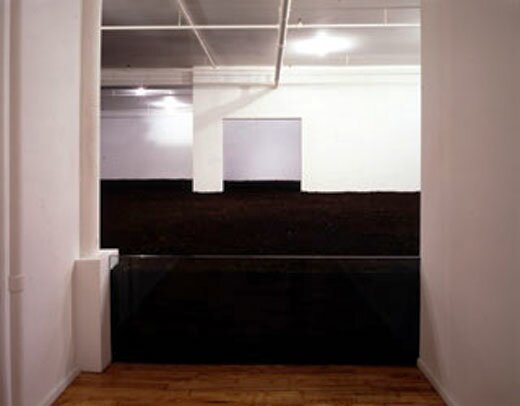
The New York Earth Room by Walter de Maria
Cities & The Dead
What makes Argia different from other cities is that it has earth instead of air. The streets are completely filled with dirt, clay packs the rooms to the ceiling, on every stair another stairway is set in negative, over the roofs of the houses hang layers of rocky terrain like skies with clouds. We do not know if the inhabitants can move about the city, widening the worm tunnels and the crevices where roots twist: the dampness destroys people’s bodies, and they have scant strength; everyone is better off remaining still, prone; anyway, it is dark.
From up here, nothing of Argia can be seen; some say “It’s down below there,” and we can only believe them. The place is deserted. At night, putting your ear to the ground, you can sometimes hear a door slam.
— Italo Calvino, (trans. William Weaver)
Posted by ben on 04 Jan 2008 | Tagged as: books, video/film
I used to post a lot more experimental cinema on Emvergeoning, digging through YouTube when I couldn’t think of anything interesting to write about. Examples include films by Phill Niblock (of a Sun Ra performance), Edgar Varèse (Poème électronique), Nam June Paik and Jud Yalkut (Electronic Moon #2), Piotr Kamler (Une Mission Ephemere), Harry Smith (Color Study), and others.
For those of you who miss those days, Andrew of The Expanded Field just pointed out a blog devoted entirely to experimental video and film called Expanded Cinema (which is also the title of a great book on the subject). Just thought you might want to know.
Posted by ben on 14 Dec 2007 | Tagged as: books, essays, vs., wordy
“Prosaically, lunk-literal-mindedly, I’ve wondered to what extent Pollock was being subliminally influenced by the color images of telescopic deep space suddenly proliferating in all the popularizing magazines and books and movies of the period. And, too, I’ve wondered about the human scale — the place of the human in the unfolding drama. Standing before such paintings, I can get to feeling positively infinitesimal (less than minuscule, a merest speck, utterly, in Greenberg’s phrase, “beside the point”); or, alternatively, as my eyes sweep the canvas and my mind identifies, momentarily, with the glory of the painting’s making, I can get to feeling almost godlike. One is reminded of the various self-dramatizing films of Pollock around the time he was making those paintings — a Colossus striding purposefully from side to side, pausing, stabbing, hurling the universe itself into existence.” — Lawrence Weschler,
“Henceforth, when man is for once overcome by the horror of alienation and the world fills him with anxiety, he looks up (right or left, as the case may be) and sees a picture. Then he sees that the I is contained in the world, and that there really is no I, and thus the world cannot harm the I, and he calms down; or he sees that the world is contained in the I and that there really is no world, and thus the world cannot harm the I, and he calms down. And when man is overcome again by the horror of alienation and the I fills him with anxiety, he looks up and sees a picture; and whichever he sees, it does not matter, either the empty I is stuffed full of world or it is submerged in the flood of the world, and he calms down.
“But the moment will come, and it is near, when man, overcome by horror, looks up and in a flash sees both pictures at once. And he is seized by a deeper horror.” — Martin Buber,
Posted by ben on 03 Dec 2007 | Tagged as: books, design, essays, responses/reviews
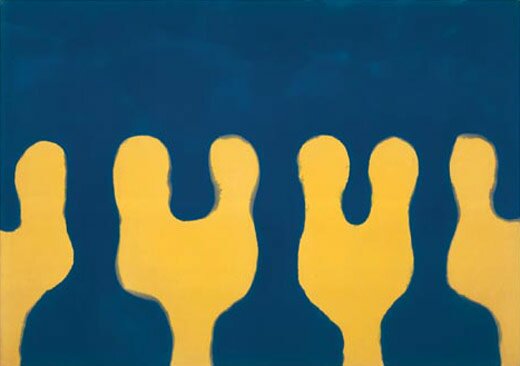
I just got an email asking why we hadn’t covered the Paul Feeley show currently on exhibit at Lawrence Markey, and my excuse was that I’m not good at writing about that kind of art. However, it’s an impressive show, and deserves more attention. So I decided to quote from a catalog / book of Feeley’s work put out by Matthew Marks and Lawrence Markey back in 2002. This passage is from a short essay about Feeley written by Lane Relyea. is definitely worth picking up if you are interested in Feeley’s work. I’ll also take this opportunity to scold our San Antonio readers for not attending Lawrence Markey’s openings with more consistency (you know who you are) — he consistently puts together great shows by important artists.
Feeley’s paintings from the ’60s betray too much of High Modernism’s earnest optimism to be characterized as primarily subversive, and yet it’s also hard to see them as bent on autonomy. With their extendable patterns of simple, interlocking forms and their nondeclarative quality gained by the back-and-forth play of assertive and recessive shapes, they’re too suggestive of tiles, fabrics, and other such prosaic materials. These references might in turn place Feeley’s art within [Constructivism], except that there’s no mistaking Feeley for a harbinger of revolution. Feeley’s mature work seems to bear the influence of postwar industrial and commercial design and the intense interest paid to it by college art curricula, lifestyle magazines, and museum curating (including the series of “Good Design” shows MoMA mounted in the early ’50s). In Feeley, as in all these instances, the attempt to merge art and life was made without any nervous glancing at the clock of revolutionary history. Historical time-keeping was also a prominent feature of Modernist painting as Clement Greenberg conceived it, which may help to explain why the critic’s support for Feeley was only lukewarm. Paintings were less likely to participate in grand historical advances if they nestled too comfortably in the private spaces of home and daily social life, where history loses sight of its main actors and staging grounds, its leaders and elections and wars, and instead moves almost imperceptibly.
Posted by ben on 10 Nov 2007 | Tagged as: announcements, books, interviews
My interview with Alan Licht is now available in the newest issue of NeoAztlan. Also in this issue: Kate Green interviews Angela Bulloch and Steve Peralta interviews Ioana Nemes. Licht’s on sound art came out this week as well; look for my review in the upcoming issue of Artlies.
Posted by michelle on 19 Oct 2007 | Tagged as: books, comics, responses/reviews
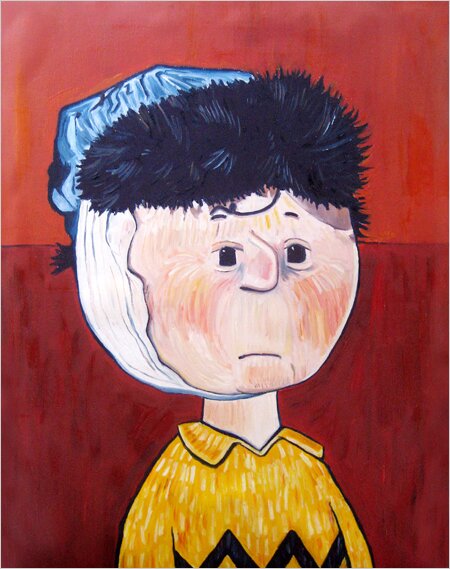
NY Times ran a great article about the tortured life of Peanuts’ creator, Charles Schultz. This graphic by Kim Scafuro had me in stitches. A new biography by David Michaelis spurred the article. Michaelis paints a melancholic picture of the beloved cartoonist, seven years post mortem. Reporter Randy Kennedy makes good use of references from Balzac to Toulouse-Lautrec with lots of levity in between. The last line lets Schultz speak for himself and it makes me wonder if Pig Pen wasn’t Schultz walking around with a little, scribbly cloud hovering above him everyday.
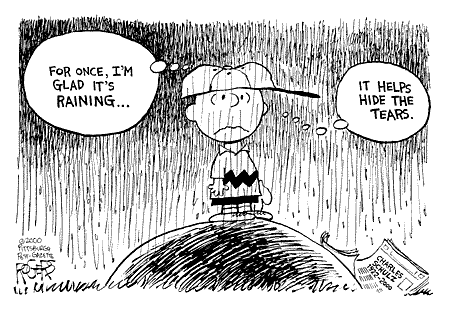
Another excerpt?
Posted by ben on 13 Oct 2007 | Tagged as: books, poetry
In the Animal Shelter
Every time you see a beautiful woman, someone is tired of her, so the men say. And I know where they go, these women, with their tired beauty that someone doesn’t want — these women who must live like the high Sierra white pine, there since before the birth of Christ, fed somehow by the alpine wind.
They reach out to the animals, day after day smoothing fur inside the cage, saying, “How is Mama’s baby? Is Mama’s baby lonesome?”
The women leave at the end of the day, stopping to ask an attendant, “Will they go to good homes?” And come back in a day or so, stooping to examine a one-eyed cat, asking, as though they intend to adopt, “How would I introduce a new cat to my dog?”
But there is seldom an adoption; it matters that the women have someone to leave, leaving behind the lovesome creatures who would never leave them, had they once given them their hearts.
— Amy Hempel (from At the Gates of the Animal Kingdom, you should buy )
Posted by ben on 11 Oct 2007 | Tagged as: books, essays, poetry
The history of the infinite circle (no, not that infinite circle), from the Corpus Hermeticum to Borges. Don’t miss the Paul Klee material. (This information will come in handy.)
Posted by michelle on 25 Jun 2007 | Tagged as: books
 Hello friends. All apologies for slow posts this week. Ben flew out of town and I’ve been preoccupied with Bunnyphonic projects. I just finished reading Miranda July’s new collection of short stories. Get thee to a library, oh, which by the way finally has wi-fi here in San Antonio. So, here’s a list of things to do this week:
Hello friends. All apologies for slow posts this week. Ben flew out of town and I’ve been preoccupied with Bunnyphonic projects. I just finished reading Miranda July’s new collection of short stories. Get thee to a library, oh, which by the way finally has wi-fi here in San Antonio. So, here’s a list of things to do this week:
* Read “” by Miranda July
* Go see Gary Sweeney’s new work at Parchman Stremmel [ no relation to Hammacher Schlemmer]
* Read the entire article on The Splasher in the New York Magazine, it’s all about the vandalism of vandalism in busy NYC.
* Practice drawing blind contours. It’s good for your constitution. This one is from EEfje in the Netherlands.
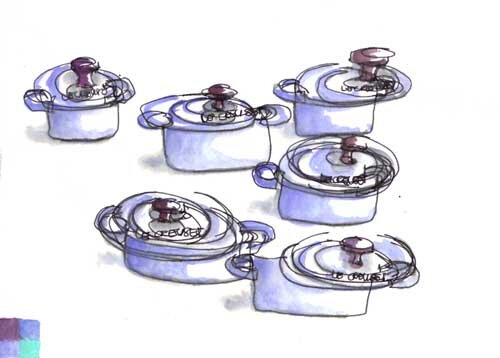
Posted by michelle on 09 Jun 2007 | Tagged as: announcements, books, in yo face
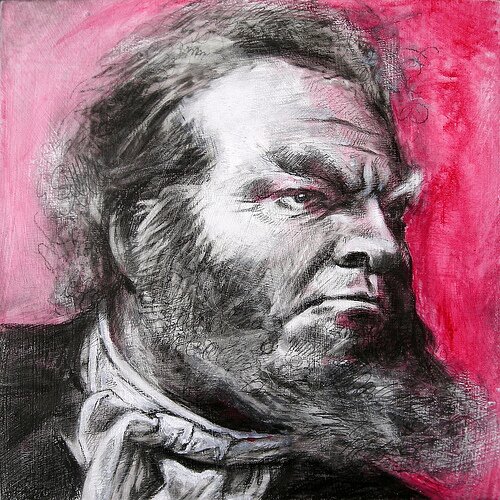
If you’re in Southtown this week, make sure to stop by Sala Diaz and check out Stevan Zivadinovic’s series of portraits: “Orson Welles vs. The Burning Dumpster.” Here’s Orson excised from a scene in Moby Dick.
Posted by michelle on 25 May 2007 | Tagged as: books, performance art, poetry
Posted by michelle on 31 Mar 2007 | Tagged as: books, ice, responses/reviews
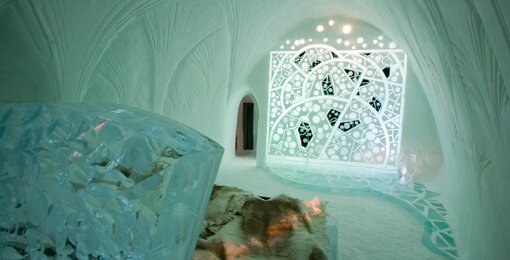
Upon investigating a recommendation from the bookworms over at Boldtype, I decided to read Let the by California writer and Believer co-editor Vendela Vida. This short book claws through the cavernous roots of a father’s death, a mother’s abandonment and a brittle change of heart. While the main character, Clarissa, searches for emotional terra firma across the bright cold unfamiliar territory of Lapland, she discovers brutal family secrets and the kindness of bucolic, reindeer herders. The locations indulge your imagination, particularly the puzzling phenomena of a luxurious Ice Hotel. The narration leads you along a dark path, but Vida tenders a very American, luminous denouement. Highly recommended for a self-absorbed, rainy afternoon investment.